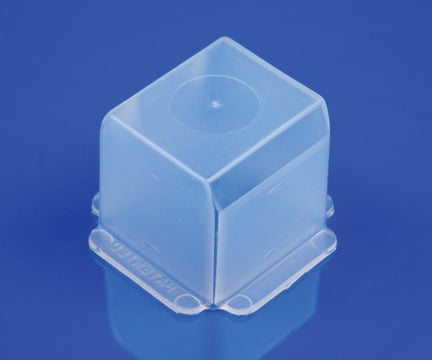SHH0026
PolyFreeze Tissue Freezing Medium
clear
Sinônimo(s):
support matrix for tissue sectioning
Faça loginpara ver os preços organizacionais e de contrato
About This Item
Código UNSPSC:
12171500
NACRES:
NA.47
Produtos recomendados
cor
clear
aplicação(ões)
hematology
histology
temperatura de armazenamento
room temp
Procurando produtos similares? Visita Guia de comparação de produtos
Categorias relacionadas
Descrição geral
Tissue samples may be snap frozen using PolyFreeze with isopentane and liquid nitrogen, dry ice (slush/slurry or bunker), or in a cryostat.
PolyFreeze media do not cause autofluorescence and can easily be washed away during tissue fixation when rinsed prior to staining. Once rinsed off the slide, there is no trace of the support matrix to interfere with staining or immunohistochemistry (IHC) reactions.
Standard frozen sections at 3–6 μm are easy to obtain and mount on glass slides for drying and/or fixation prior to staining, while thicker sections can be taken as required. Sections will flow freely under an anti-roll device, allowing flat sections to be picked up from the knife-edge. Sections can be either fixed immediately in the fixative of choice or air dried for later fixation and staining. Drying or fixing the slides in the cryostat for specific procedures will not affect the PolyFreeze medium.
um are easy to obtain and mount on glass slides for drying and/or fixation prior to staining, while thicker sections can be taken as required. Sections will flow freely under an anti-roll device, allowing flat sections to be picked up from the knife-edge. Sections can be either fixed immediately in the fixative of choice or air dried for later fixation and staining. Drying or fixing the slides in the cryostat for specific procedures will not affect the PolyFreeze medium.
PolyFreeze media do not cause autofluorescence and can easily be washed away during tissue fixation when rinsed prior to staining. Once rinsed off the slide, there is no trace of the support matrix to interfere with staining or immunohistochemistry (IHC) reactions.
Standard frozen sections at 3–6 μm are easy to obtain and mount on glass slides for drying and/or fixation prior to staining, while thicker sections can be taken as required. Sections will flow freely under an anti-roll device, allowing flat sections to be picked up from the knife-edge. Sections can be either fixed immediately in the fixative of choice or air dried for later fixation and staining. Drying or fixing the slides in the cryostat for specific procedures will not affect the PolyFreeze medium.
um are easy to obtain and mount on glass slides for drying and/or fixation prior to staining, while thicker sections can be taken as required. Sections will flow freely under an anti-roll device, allowing flat sections to be picked up from the knife-edge. Sections can be either fixed immediately in the fixative of choice or air dried for later fixation and staining. Drying or fixing the slides in the cryostat for specific procedures will not affect the PolyFreeze medium.
Aplicação
A support matrix or form of embedding medium for frozen sectioning. This medium freezes quickly supporting the tissue for sectioning at 3 μ and up with no cracking of the matrix at temperatures from -8 °C to -25 °C. Snap freeze using PolyFreeze with isopentane and liquid nitrogen or dry ice (slush/slurry or bunker). Store specimens frozen in PolyFreeze in liquid nitrogen canisters or in airtight containers in a -80 °C freezer.
Cryo-embedding matrix for frozen specimens.
PolyFreeze tissue freezing medium has been used in immunohistochemistry.
PolyFreeze tissue freezing medium has been used in immunohistochemistry.
Características e benefícios
- Colored PolyFreeze (blue, green, yellow) makes differentiating multiple specimens easy during sectioning and staining
- Experience less curling, less ice artifacts, faster freezing with PolyFreeze
Armazenamento e estabilidade
Store PolyFreeze tissue freezing medium at room temperature. A cloudy appearance of the unfrozen product has no effect on performance.
Store specimens frozen in PolyFreeze medium in liquid nitrogen canisters or in airtight containers in a -80 0C freezer.
Store specimens frozen in PolyFreeze medium in liquid nitrogen canisters or in airtight containers in a -80 0C freezer.
Código de classe de armazenamento
10 - Combustible liquids
Classe de risco de água (WGK)
WGK 1
Ponto de fulgor (°F)
>230.0 °F
Ponto de fulgor (°C)
> 110 °C
Certificados de análise (COA)
Busque Certificados de análise (COA) digitando o Número do Lote do produto. Os números de lote e remessa podem ser encontrados no rótulo de um produto após a palavra “Lot” ou “Batch”.
Já possui este produto?
Encontre a documentação dos produtos que você adquiriu recentemente na biblioteca de documentos.
Os clientes também visualizaram
TGF-β1 and IL-10 expression in epithelial ovarian cancer cell line A2780.
Feng X, et al.
Tropical Journal of Pharmaceutical Research, 14(12), 2179-2185 (2015)
An ex vivo gene therapy approach in X-linked retinoschisis.
Bashar A E, et al.
Molecular Vision, 22, 718-718 (2016)
Shweta Kukreja et al.
Developmental biology, 467(1-2), 95-107 (2020-09-14)
The retinotectal system has been extensively studied for investigating the mechanism(s) for topographic map formation. The optic tectum, which is composed of multiple laminae, is the major retino recipient structure in the developing avian brain. Laminar development of the tectum
Nossa equipe de cientistas tem experiência em todas as áreas de pesquisa, incluindo Life Sciences, ciência de materiais, síntese química, cromatografia, química analítica e muitas outras.
Entre em contato com a assistência técnica







